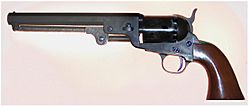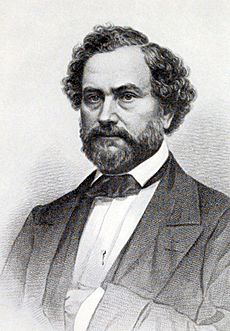Daniel Leavitt facts for kids
Quick facts for kids
Daniel Leavitt
|
|
|---|---|
| Born |
Daniel Leavitt
November 16, 1813 Rye, New Hampshire, United States
|
| Died | July 27, 1859 (aged 45) Chicopee, Massachusetts, United States
|
| Occupation | Inventor, arms maker |
| Spouse(s) | Ruth Jeannette Ball |
Daniel Leavitt (November 16, 1813 – July 27, 1859) was an early American inventor. He worked with his partner Edwin Wesson to create one of the first revolvers after Samuel Colt invented his. They also made one of the first American revolving pistols.
Their new design was only made for a short time. This was because Samuel Colt sued them over his patent. Colt's lawsuit forced their company to stop making the Leavitt & Wesson Dragoon revolver. However, Leavitt's early inventions and those of his partner, Edwin Wesson, helped create competition. This competition led to many new ideas and products in the firearms industry we know today.
Contents
Early Life
Daniel Leavitt was born on November 16, 1813, in Rye, New Hampshire. His father, Benning Leavitt, was a successful businessman and a state senator. His mother was Olive (Jenness) Leavitt.
In 1838, Daniel Leavitt married Ruth Jeannette Ball in West Springfield, Massachusetts. They had three children together.
Leavitt's Invention and Patent
Leavitt received a patent for his new gun design on April 29, 1837. A patent is like a special permission from the government that says only you can make or sell your invention for a certain time. The United States Patent and Trademark Office gave him patent number 182 for an "improvement in many-chambered cylinder fire-arms."
This early weapon was the second of its kind. It was a .40-caliber percussion revolver. This means it used a special type of ammunition and had a cylinder that held six shots. It was a single-action gun with a 6+3⁄4-inch barrel.
Leavitt got his patent less than a year after Samuel Colt received his own patent for the revolver. Colt had not even started selling his new gun yet. Leavitt's patent was granted when he lived in Cabotville, Massachusetts, which is now part of Chicopee, Massachusetts.
Leavitt's design was special in one way. He wrote in his patent application, "The improvement which I have made consists in giving a convex form to that end of the revolving cylinder which is in contact with the barrel." This means the part of the cylinder that touched the barrel was curved outwards.
This curved shape was Leavitt's big idea. It was designed to push the flash from a fired shot away from the other chambers. This helped prevent all the bullets from firing at once, which was a big problem with early revolvers.
In 1838, the Journal of the Franklin Institute in Philadelphia wrote about Leavitt's design. They noted that his invention made the end of the cylinder curved. This helped to draw off the smoke and flash from the cartridge explosions.
Early Gun Making
Leavitt's early patent showed that many people were coming up with new ideas in the firearms industry. This was a time of great competition as the industry was just starting. In the same year Leavitt got his patent, two other inventors also received patents for new ideas in multi-chambered firearms. Samuel Colt had received his U.S. patent for a "revolving gun" on February 25, 1836.
Leavitt's revolvers were first made in small numbers by a company called Wesson, Stephens & Miller in Hartford, Connecticut. In 1839, Edwin Wesson, who owned the company and was also an inventor, changed Leavitt's original design. He called the new gun the "Wesson & Leavitt" revolver.
Edwin Wesson started making these guns at a factory in Massachusetts. This led to the creation of the Massachusetts Arms Company in Chicopee Falls, Massachusetts. After Edwin Wesson received his own patent in 1850 (after he had passed away), the first Wesson & Leavitt revolvers were made. This huge .40-caliber handgun weighed over 4 pounds and was almost 15 inches long. The barrel itself was 7.1 inches long.
Around 1850 and 1851, the company made about 800 of these new revolvers. You could reload them easily by pressing a latch, lifting the barrel, and pulling the cylinder forward. Besides the standard model, they also made about a thousand smaller .31-caliber "Belt models" with shorter barrels.
Customers really liked these new revolvers. For example, General Winfield Scott carried one of the smaller Wesson & Leavitt .32-caliber revolvers during the Mexican–American War.
Samuel Colt's Lawsuit
The success of the Massachusetts Arms Company's gun soon got the attention of Samuel Colt. He sent his cousin, Henry Sargeant, to buy one of their revolvers. Colt had recently gotten his original patent extended until 1857. This made him confident enough to sue Wesson & Leavitt.
At this time, Edwin Wesson's brother, Daniel Wesson, was running the company. Daniel had started working for his brother Edwin in 1843 and took over after Edwin's death in 1849. Colt's lawsuit claimed that Wesson & Leavitt were using his original patent without permission.
The case went to court in October 1852 in New York. Both sides accused each other of changing original patent documents and using fake evidence. Newspapers in New York City covered the case a lot. A month later, Colt won the case against the smaller company and was awarded a lot of money.
The Massachusetts Arms Co. kept making revolvers. They tried different ways to make the cylinder turn to avoid Colt's patents. The original company closed down after the Civil War in 1866.
After Colt won, his lawyer, Edward N. Dickerson, sent a warning letter to other gun makers. He told them to "stop immediately from the sale of any REPEATING FIRE ARMS" that used certain designs, unless they were made by Colt in Hartford.
This warning made many American gun companies very nervous. Many of the companies that received the warning paid money to settle with Colt. Even with this early win, Colt's lawyer warned him not to keep suing. He said that it's easy to start a big lawsuit, but harder to win it successfully. He also said that Colt had been very lucky so far, but his luck could change.
Despite his lawyer's warning, Colt's lawsuits had a big effect. They almost stopped his competitors from making guns for several years. Colt's company became the biggest maker of guns for regular people during the 1850s.
After the Lawsuit
The Massachusetts Arms Company is seen as an early version of the famous gun maker Smith & Wesson. They made about a thousand of the .31-caliber belt models of the original patented revolver. In 1856, the Massachusetts-Kansas Aid Committee, a group that supported the end of slavery, bought 200 of these guns. Many of these firearms later went to the abolitionist John Brown.
The Massachusetts Arms Company stayed in business. After some of Samuel Colt's original patents ran out, and with new improvements to their own gun designs, the company made many different weapons. Some of their early employees, like designer Joshua Stevens, went on to start other successful gun companies. For example, the J. Stevens Company was later sold to New England Westinghouse Company in 1915 to make guns for World War I.
Even though Daniel Leavitt was eventually defeated by Samuel Colt's legal team, he helped push for new ideas and improvements in American pistols. These guns were later used in the Old West, the American Civil War, and other places. They were admired by gun makers around the world.
Leavitt also served in the Massachusetts Volunteer Militia in 1847 as a Captain. He was also a member of the Chicopee Freemasons group.
Daniel Leavitt didn't only design guns. On August 18, 1842, he received another patent (number 2755). This one was for a "Mode of Securing Bobbins in Shuttles for Weaving." Bobbins are spools used in weaving machines. This patent showed that Leavitt was also interested in another growing industry in New England. This industry was important to him because his father, Benning, owned a factory in Chicopee that made bobbins. We don't know if Leavitt's patent for textile manufacturing was more successful than his gun patents.
Death
Daniel Leavitt died in Chicopee, Massachusetts, on July 27, 1859.



